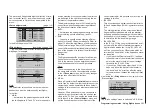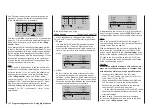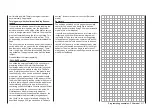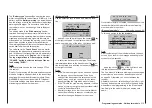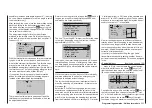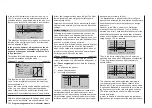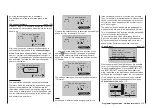
314 Programming examples - F3A model
F3A model
F3A models are a part of the group of motor-driven
winged models. They are powered by a combustion
or electric motor. Electric-powered model aircraft
are now becoming prevalent in the international F3A
model aerobatic class as well as being eligible for the
F5A electric aerobatic class.
The basic comments and notices for the mechanical
installation of a remote steering system, which was
already referred to in the first programming example
on page 280, also applies, of course, for F3A mo-
dels and does not need to be mentioned here again.
Faultlessly constructed F3A models exhibit a largely
neutral flying behavior. Ideally, they react with a good
nature but precisely to control movements without the
individual flight axes influencing one another.
F3A models are controlled with ailerons, elevator and
rudders. Normally, each aileron is actuated by a sepa-
rate servo. There is also the regulation of the drive
output of the motor (throttle function) and a retract-
able landing gear in many cases. The assignment of
the channels 1 to 5, therefore, do not differ from the
previously described winged models.
The additional “Retractable landing gear” function is
to be provided on one of the auxiliary channels 6 to 8
or 6 … 12. It is best to actuate the landing gear with
a switch without center position. In addition, another
mix offset for the carburetor can – if necessary – be
provided. You normally use one of the two propor-
tional controls on the transmitter, which actuates one
of the unassigned auxiliary channels.
Receiver power supply
Free or aux. function
Free or aux. function
Rudder
Aileron or left aileron
Elevator or 1st elevator
Free or 2nd elevator or aux. function
Receiver power supply
Airbrake or throttle servo
or speed controller (electric motor)
Right aileron
Free or aux. function (retracts)
Free or aux. function (mixture)
Free or aux. function
Free or aux. function
With the assignment of auxiliary channels at the
transmitter, we recommend making sure that the
operating elements required for this are easily within
reach, because during flight – especially in competi-
tion – you have “very little time” to release the stick.
Programming procedure
Since the basic programming of the transmitter was
already described in detail on pages 280 … 287,
only F3A-specific tips are added here.
In the menu …
»Servo adjustment«
S1
S2
S3
Rev cent
+
trv
0%
0%
0%
100% 100%
100% 100%
100% 100%
0%
0%
100% 100%
100% 100%
S4
S5
… the settings for the servos are carried out. Experi-
ence has shown that working with at least 100 % ser-
vo throw is beneficial, because the control precision
is significantly better if greater servo travel is used.
This should already be taken into account during the
construction of the model in the design of the rudder
linkages. Check the servo’s direction of rotation. The
servo center should be adjusted mechanically, insofar
as possible.
Any corrections can be made on the software side in
the third column during the initial test flights.
Through the menu …
»Model type«
… the idle trim is activated for Channel 1 (normally
“back”, because full throttle is “front”). The trimming
then only works in the idle direction:
Tail type
Motor at C1
Normal
Aile/flaps
2AIL
Model type
Brake Off
In 1
+100%
SEL
back
The remaining settings are made or left as shown in
the figure.
After the model is test-flown and trimmed, we
recommend reducing trim travel for the elevator and
ailerons. The model has significantly less of a reaction
to a movement of the trim lever. “Over-trimming” can
be avoided, because with full trim travel, under cer-
tain circumstances, the movement by just one trim-
ming step can have too strong of an effect: Therefore,
the model which previously pulled slightly to the left,
hangs somewhat to the right after the trimming. This
is accomplished by moving to the …
Summary of Contents for HoTT MC-16 Series
Page 1: ...Programming Manual mc 16 mc 20 HoTT 1 en mc 16 mc 20...
Page 27: ...27 For your notes...
Page 53: ...53 For your notes...
Page 61: ...61 For your notes...
Page 65: ...65 For your notes...
Page 71: ...71 For your notes...
Page 103: ...103 For your notes...
Page 107: ...107 For your notes...
Page 111: ...111 For your notes...
Page 155: ...155 For your notes...
Page 165: ...165 For your notes...
Page 201: ...201 For your notes...
Page 229: ...229 For your notes...
Page 231: ...231 For your notes...
Page 261: ...261 For your notes...
Page 265: ...265 For your notes...
Page 301: ...301 For your notes...
Page 327: ...327 For your notes...
Page 328: ...328 For your notes...




